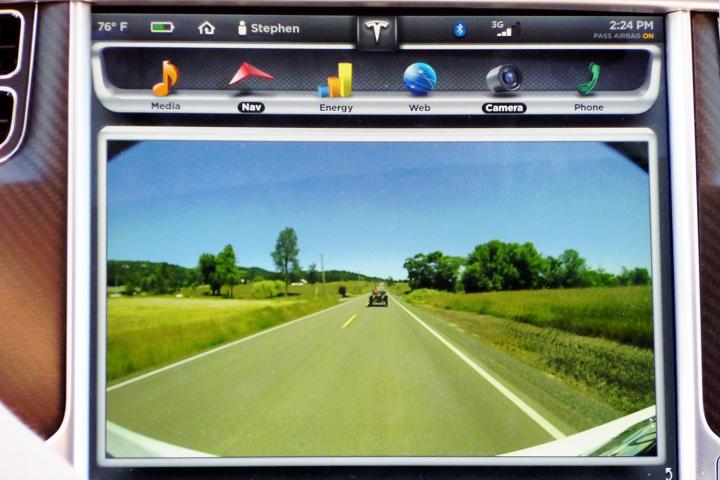
Tesla headmaster Elon Musk is apparently taking a deep breath and holding his nose as his company wades into the stink of American transportation bureaucracy to do away with another remnant of no-tech cars: rear-view mirrors. Musk would like to see them go the way of the internal combustion engine. I fully support his efforts on this front.
Ever been in a Tesla Model S? The interior sports a massive vertical 17-inch touchscreen for controlling every aspect of the car, with only a handful of physical “buttons” inside.
One view you can leave up full-time on half of the screen while driving is the live panoramic wide-angle view from the rear-mounted backup camera, which is great since the low-tech windshield-mounted rearview mirror can basically show you who’s in the back seats and not much more.
And gliding down the highway with the rear-view camera on is fairly hypnotic in a “wow, why doesn’t every car have this safety feature?” kind of way.
Rear-rear view mirrors first appeared on cars in 1914, according to a post on Green Car Reports which details Musk’s efforts to get rid of them, at least on his cars. Why? Namely: drag. Sticking those ancient optical ears on cars, especially low-Cg missiles like the Model S and others, results in a significant increase in drag, between 3 and 6 percent Green Car Reports says. Of course, that added drag requires engine or motor power to overcome.
Don’t think 6 percent is very much? Let’s say your car has a range of 200 miles with mirrors. Not having to push them through the air at highway speeds could tack on 10 to 12 miles of range. Not a small deal, especially for electric vehicles.

Still not convinced? Drive your car on the freeway at 65mph, roll down the window and stick your hand out, palm front, and see how long you can hold it there. No cheating by holding it behind the mirror! Hard to keep it there, right? Now multiply by two and that’s what your car is pushing down the road at freeway speeds all the time, and that’s just for small mirrors.
Video camera technology has advanced to the point where it’s pretty much bomb-proof. Got a cell phone that shoots video? Pretty reliable, no? Cheap, too. I’d bet a wide-angle HD camera that could function as a side-view mirror actually costs less than making a regular side-view mirror, especially if the mirror has motorized adjustments for viewing angles. Plus, they’re really, really tiny, like this one:

Back-up cameras are getting pretty common, even in new low-buck car models and some new cars, like a recent Mercedes and Infinity we reviewed, now feature multiple cameras that give a 360-degree view of the area surrounding the car for parking assistance and situational awareness – a worthy feature. Installing cameras as side-view mirrors and putting the display in a heads-up (HUD) configuration would increase driver safety since you would not need to take your eyes off the road like you do now to look in the mirrors.
Additionally, video camera-based systems could have more features, like night-vision and object avoidance, that could increase safety in ways regular mirrors can’t and never will. A video system that looks completely around the car and records to an in-car DVR for a short time (say, 10 minutes) before over-writing the footage could be a boon in a traffic crash, easily identifying who is at fault. I’ll take that discount on my insurance, thank you very much.
So keep that clothes pin on your nose as you try to machete through the myriad volumes of size and functionality regulations, warning labels and optical-grade statutes for mirrors, Elon. Cars will look and perform better without them. Hopefully we can see this ancient aspect of vehicle safety tech eventually disappear into our rearview cameras.
What say you? Rearview HUDs or old-school polished glass? Speak your piece in comments.
Editors' Recommendations
- Watch Tesla’s new promo video showing off the Cybertruck
- This Tesla video manages to make battery production look cool
- Elon Musk wants to add videoconferencing to Tesla cars


